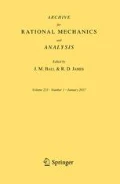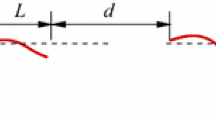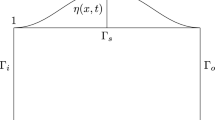Abstract
In this paper we consider an initial and boundary value problem that models the self-propelled motion of solids in a bidimensional viscous incompressible fluid. The self-propelling mechanism, consisting of appropriate deformations of the solids, is a simplified model of the propulsion mechanism of fish-like swimmers. The governing equations consist of the Navier–Stokes equations for the fluid, coupled to Newton’s laws for the solids. Since we consider the case in which the fluid–solid system fills a bounded domain we have to tackle a free boundary value problem. The main theoretical result in the paper asserts the global existence and uniqueness (up to possible contacts) of strong solutions of this problem. The second novel result of this work is the provision of a numerical method for the fluid–solid system. This method provides a simulation of the simultaneous displacement of several swimmers and is tested on several examples.
Similar content being viewed by others
References
Borelli G. (1989) On the Movement of Animals. Springer, New York
Boukir K., Maday Y., Métivet B., Razafindrakoto E. (1997) A high-order characteristics/finite element method for the incompressible Navier–Stokes equations. Int. J. Numer. Methods Fluids 25, 1421–1454
Boulakia M. (2003) Existence of weak solutions for the motion of an elastic structure in an incompressible viscous fluid. C. R. Math. Acad. Sci. Paris 336, 985–990
Carling J., Williams T., Bowtell G. (1998) Self-propelled anguilliform swimming: simultaneous solution of the two-dimensional Navier–Stokes equations and Newton’s laws of motion. J. Exp. Biol. 201, 3143–3166
Chambolle A., Desjardins B., Esteban M.J., Grandmont C. (2005) Existence of weak solutions for the unsteady interaction of a viscous fluid with an elastic plate. J. Math. Fluid Mech. 7, 368–404
Childress S. (1981) Mechanics of Swimming and Flying, vol. 2 of Cambridge Studies in Mathematical Biology. Cambridge University Press, Cambridge
Coutand D., Shkoller S. (2005) Motion of an elastic solid inside an incompressible viscous fluid. Arch. Ration. Mech. Anal. 176, 25–102
Coutand D., Shkoller S. (2006) The interaction between quasilinear elastodynamics and the Navier–Stokes equations. Arch. Ration. Mech. Anal. 179, 303–352
Cumsille P., Tucsnak P. (2006) Wellposedness of the Navier–Stokes flow in the exterior of the rotating obstacle. Math. Methods Appl. Sci. 29, 595–623
Cumsille, P., Takahashi, T.:Wellposedness for the system modelling the motion of a rigid body of arbitrary form in an incompressible viscous fluid. Czechoslovak Math. J. (to appear)
Desjardins B., Esteban M., Grandmont C., Le Tallec P. (2001) Weak solutions for a fluid-elastic structure interaction model. Rev. Math. Comput. 14, 523–538
Desjardins B., Esteban M.J. (1999) Existence of weak solutions for the motion of rigid bodies in a viscous fluid. Arch. Ration. Mech. Anal. 146, 59–71
Feireisl E. (2003) On the motion of rigid bodies in a viscous incompressible fluid. J. Evol. Equ. 3, 419–441
Galdi G. (1999) On the steady self-propelled motion of a body in a viscous incompressible fluid. Arch. Ration. Mech. Anal. 148, 53–88
Galdi G.P.: On the motion of a rigid body in a viscous liquid: a mathematical analysis with applications. In: Handbook of Mathematical Fluid Dynamics, Vol. I, pp. 653–791. North-Holland, Amsterdam, 2002
Gray J. (1932) Study in animal locomotion IV—the propulsive powers of the dolphin. J. Exp. Biol. 10, 192–199
Gray J. (1936) Study in animal locomotion I—the movement of a fish with special reference to the eel. J. Exp. Biol. 13, 88–104
Gunzburger M., Lee H.-C., Seregin G. (2000) Global existence of weak solutions for viscous incompressible flows around a moving rigid body in three dimensions. J. Math. Fluid Mech. 2, 219–266
Inoue A., Wakimoto M. (1977) On existence of solutions of the Navier–Stokes equation in a time dependent domain. J. Fac. Sci. Univ. Tokyo Sect. IA Math. 24, 303–319
Kanso E., Marsden J.E., Rowley C.W., Melli-Huber J.B. (2005) Locomotion of articulated bodies in a perfect fluid. J. Nonlin. Sci. 15, 255–289
Kelly S.D., Murray R.M. (1998) Modelling efficient pisciform swimming for control. Int. J. Robust Nonlin. Control 201, 3143–3166
Ladyzhenskaya O. (1969) The Mathematical Theory of Viscous Incomprehensible Flow. Gordon and Breach Science, New York
Leroyer A., Visonneau M. (2005) Numerical methods for ranse simulations of a self-propelled fish-like body. J. Fluids Struct. 20, 975–991
Lighthill J.: Mathematical Biofluiddynamics. Society for Industrial and Applied Mathematics, Philadelphia, 1975
Lions J.-L., Magenes, E.: Non-homogeneous boundary value problems and applications, Vol. I. Springer, New York, 1972. Translated from the French by P. Kenneth, Die Grundlehren der mathematischen Wissenschaften, Band 181
Liu H., Kawachi K. (1999) A numerical study of undulatory swimming swimming. J. Comput. Phys. 155, 223–247
Maury B., Glowinski R. (1997) Fluid-particle flow: a symmetric formulation. Acad C. R. Sci. Paris Sér. I Math. 324, 1079–1084
San Martín J., Scheid J.-F., Takahashi T., Tucsnak M. (2005) Convergence of the Lagrange–Galerkin method for the equations modelling the motion of a fluid-rigid system. SIAM J. Numer. Anal. 43, 1536–1571
San Martín J., Starovoitov V., Tucsnak M. (2002) Global weak solutions for the two-dimensional motion of several rigid bodies in an incompressible viscous fluid. Arch. Ration. Mech. Anal. 161, 113–147
Sparenberg J.A. (2002) Survey of the mathematical theory of fish locomotion. J. Eng. Math. 44, 395–448
Takahashi T. (2003) Analysis of strong solutions for the equations modeling the motion of a rigid–fluid system in a bounded domain. Adv. Differ. Equ. 8, 1499–1532
Taylor, G.: Analysis of the swimming of long and narrow animals. Proc. R. Soc. Lond A. 214, (1952)
Temam R. (1983) Problèmes mathématiques en plasticité. Gauthier-Villars, Montrouge
Tryantafyllou M., Tryantafyllou G. (1995) An efficient swimming machine. Sci. Am. 272, 64–70
Wu, T.Y.: Mathematical biofluiddynamics and mechanophysiology of fish locomotion. Math. Methods Appl. Sci. 24, 1541–1564 (2001) Biofluiddynamics
Author information
Authors and Affiliations
Corresponding author
Additional information
Communicated by A. Bressan
Rights and permissions
About this article
Cite this article
Martín, J.S., Scheid, JF., Takahashi, T. et al. An Initial and Boundary Value Problem Modeling of Fish-like Swimming. Arch Rational Mech Anal 188, 429–455 (2008). https://doi.org/10.1007/s00205-007-0092-2
Received:
Accepted:
Published:
Issue Date:
DOI: https://doi.org/10.1007/s00205-007-0092-2




